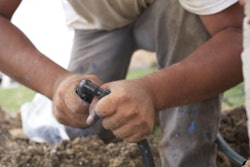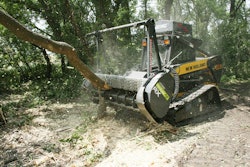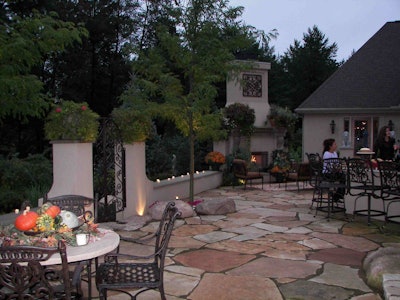 Landscape Solutions used flagstone for this outdoor living area, which is enclosed with knee walls and columns.
Landscape Solutions used flagstone for this outdoor living area, which is enclosed with knee walls and columns.Paver patios can be a relaxing space for clients to relax year round if they’re installed correctly.
To create a seamless patio, landscapers need to have certain design, material and lighting techniques in their toolbox.
Here’s how to give clients the perfect patio for their backyard.
Shapes & sizes
Like with any project, it’s important to listen to the customer and know what they want, says Joe Schaeffer, Hughes Landscaping in Poolesville, Maryland. “Do a design, even if it’s a crude scribble on a napkin,” he says. “Have a good idea of what you want to end up with, and build it in a timely manner.”
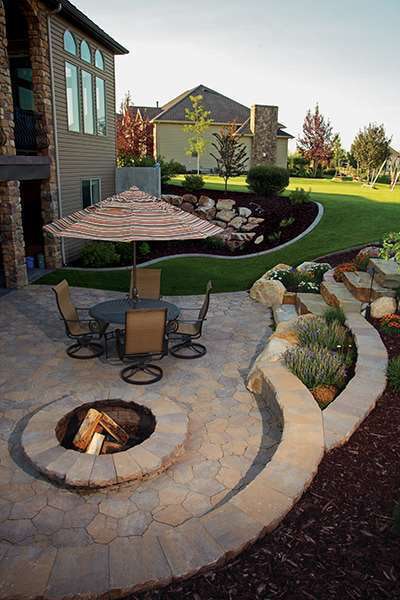 Springfalls Nursery & Landscaping used natural steps with Belgard Mega Arbel pavers for this backyard patio project.
Springfalls Nursery & Landscaping used natural steps with Belgard Mega Arbel pavers for this backyard patio project.Make sure the patio footing is solid, strong and sloped correctly, Schaeffer says.
Another part of the planning process should also include the layout. “Map out the specific pieces you want to use if you can, or follow a suggested pattern for pavers.”
Landscapers should also determine what the space is going to be used for, how many people will it need to facilitate, the lay of the land and what type of products are going to be used.
For tighter areas, Schaeffer suggests angular shapes since the property line and foundation-created restrictions are generally along straight lines.
If a client has a fire pit, a perfect-circle patio seems to be more favorable. But, Schaeffer stays away from free-form patios.
“When I have no restrictions, it will be a mix of straight lines and subtle or sweeping curves to create a more elegant look,” he says.
With the budget or space is large or small, landscapers can create the right space for any project with the right planning. “The patio being too small would only arise due to budget constraints or poor planning,” Schaeffer says. “I would be able to direct a customer to the necessary size patio based on the intended use of the space.”
“Even in a tight spot, with properly placed visual breaks – such as plantings – a patio could sit on a large majority of any defined space and not look overwhelming,” Schaeffer says.
What to avoid
Planning especially is important to prevent mistakes and creating patios that will not please clients.
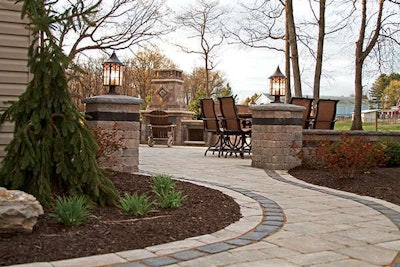 Bolder Concepts Landscape & Design used Unilock Brussels pavers and wall blocks with Unilock Courtstone banding. They also used Courtstone to create an hearth area for the fireplace.
Bolder Concepts Landscape & Design used Unilock Brussels pavers and wall blocks with Unilock Courtstone banding. They also used Courtstone to create an hearth area for the fireplace.“Total lack of creativity becomes apparent with the big-blob patios,” Schaeffer says. “People think that a patio will look good as long as they add a ton of curves all over the place. Abstract art and natural stone hardscaping rarely complement one another.”
Another issue he has seen is when poor footings have lead to a premature failure of the patio, which becomes evident when the stones start to dislodge. “Careless lay of stones is a result of poor skills.”
If landscapers want to build a random geometric stone patio, the shapes should all be quadrilateral. “It is the most standard form of a flagstone patio,” he says. “There should never be an L-shaped piece because the layer did not plan correctly.”
When it comes to joints filled with mortar, installers should make sure they never span the length of more than three stones in sequence. “Long lines within a random lay again screams poor planning,” Schaeffer says. “Mortar pouring out over the stones from the joints looks horrible, too.”
Materials
For products, he prefers natural products such as using flagstone in a variety of colors and shapes with clay pavers as accents. “Once a material is used in any portion of the yard, I like that same material to at least be complimented in all of the other additional flat spaces.”
Concrete pavers come with a range of design features and colors, so they can be preferable as well, he says. He suggests those for driveways.
“I never like to have a sea of any one material in a large patio,” Schaeffer says. “Inlays are key to break up the monotony of large patio spaces.”
Lighting tips
The demand for patio lighting continues to grow, says Andrew Coleman, outdoor lighting designer with McKay Landscape Lighting in Omaha, Nebraska.
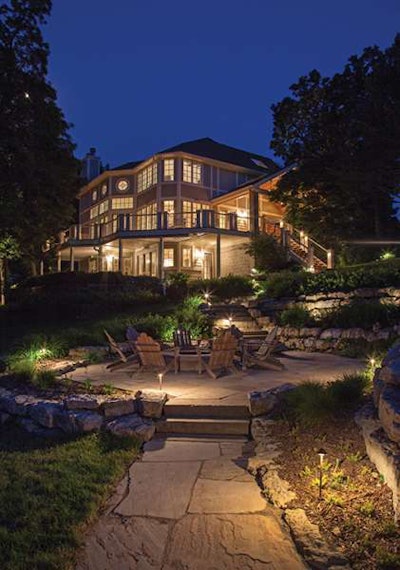 McKay Landscape Lighting illuminated this outdoor space, extending the patio’s use and creating safe walkways.
McKay Landscape Lighting illuminated this outdoor space, extending the patio’s use and creating safe walkways.“With the growth of modern technology, the homeowner has more options for lighting control to adapt to their lifestyle,” Coleman says. “Outdoor lighting is just one piece to the puzzle, but it seems to be one of the most popular options when properly installed to help extend their living space for all seasons.”
Seat wall, path and post lights are trending, Coleman says. He’s also seeing a lot of customers wanting LED tape around outdoor kitchens and specialty lights, like tiki torches or hand-blown glass spheres.
When trying to decide where to place the patio lights, Coleman suggests asking these three questions to find the answer:
- Where are the mature trees?
- Are there streetlights or a neighbor’s yard that might provide competing light?
- How will your client use their outdoor space?
Landscapers should also try to illuminate entry and exit points, changes in elevation and seating areas such as seat walls around the patio.
When adding lights, Coleman says it’s important to play ahead. “Design and install PVC sleeves under the patio or in the columns and seat walls during construction,” he says. It’s important to bring it up early on in the process.
“Unfortunately, lighting is normally the last thing people think about, but it ends up being the most enjoyment item clients pay forward after it has been installed,” Coleman says.
His clients’ favorite paver style has consistently been random geometric flagstone, and the majority of the time, they want them set in mortar over concrete.
Added features
In addition to lighting, landscape contractors can also install a variety of other components that will compliment the patio.
“Sitting walls offer a definition of the perimeter of the patio without creating a boxed-in feeling,” Schaeffer says. “Extra seating is always a bonus, as well.”
Water features and fire pits are other popular additions for hardscaped areas.
“There’s no better way to get people to use the patio at any point through the season than with a fire pit,” Schaeffer says. “We have used quite a few gas fire pits, which are extremely easy to use. Press a button on and off, and there’s no cleanup or maintenance.”


